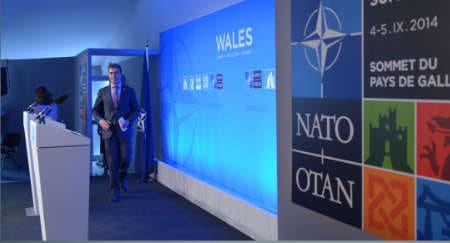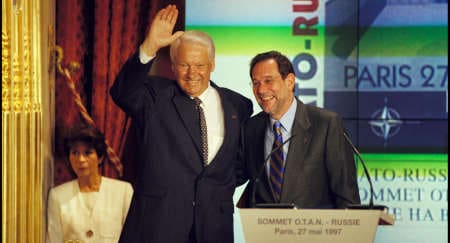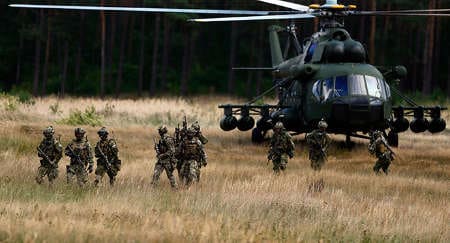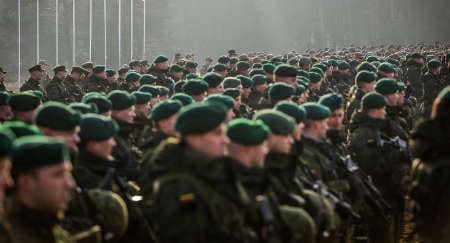NATO’s European Allies don’t need to make defence budget commitments that they can’t live up to, argues Stefan Soesanto. What they really need is to make difficult personnel cuts and start mixed nationality defence practices.
Let’s start with the good news first. Last year’s NATO summit in Newport, Wales was a positive milestone in the evolution of Europe's defence posture. To recap, the crisis-hit European states recommitted themselves to reverse the trend of declining defence budgets within the next decade, by raising their military expenditures to 2% of GDP with 20% dedicated to R&D and major equipment acquisition.
The Alliance also adopted a Readiness Action Plan (RAP) to safeguard its Eastern flank with the increase of military exercises and deployment of additional rotational NATO forces to Eastern and Central Europe. And consensus was reached on the creation of a 4000-5000 strong Very High Readiness Joint Task Force (VJTF), capable of deploying within a few days' notice by early 2015.
The disappointing part of the Wales Summit outcome is that larger defence budgets, closer military cooperation, and increased force readiness, are not going to fix the Alliance’s underlying problem of financially inefficient, politically fragmented, and strategically incoherent European allies.
First, the continuous drawdown of US military forces from Europe, from a high of 440,000 in 1957 to an all-time low of around 67,000 in 2015, has created substantial political fragmentation on the continent. This is negatively affecting Alliance cohesion and strategic decision-making to the point of mere status quo maintenance.
As a result, Moscow’s clear violation of the 1997 Helsinki Final Act, which forbids the “demand for, or act of, seizure and usurpation of part or all of the territory of any participating State”, has not prompted a drastic turnaround in Europe’s position towards the NATO-Russia Founding Act. Instead, the Alliance merely chose to reinforce its restrained security commitments towards its Eastern members, despite the dramatic changes in the continent’s overall security environment.
Second, in the absence of permanently stationed forces across NATO’s Eastern flank, the Alliance’s collective self-defence posture and long-term quest for force interoperability is being increasingly defined in political terms rather than sound deterrence strategy. True, NATO has put forward suggested increased military exercises, additional rotational forces, and the formation of a rapid response battalion. These temporarily circumvent the notion of inadequate territorial defence of NATO’s Eastern members, but do little to address the widening shortfalls of Alliance solidarity, defence commitments, and military cohesion within NATO itself.
If the dictum of ‘Vigilia Pretium Libertatis’ ought to apply to the Alliance in the 21st century, the 26 European members must adopt a holistic approach towards territorial defence rather than merely trying to compensate for the defensive weaknesses of its peripheral members in the context of possible Russian aggression.
A holistic approach to reform the Alliance would entail first and foremost the reconfiguration of NATO’s deployment strategy within Europe itself. In the same manner as the right to free movement and residence has strengthened European citizenry and the Union’s political integration, NATO needs to enhance national diversity among the armies of its member states and increase military dependencies to pivot away from a strategy based on defending its parts, towards a strategy of defending the whole.
The numbers speak for themselves. Some 25 per cent of NATO members do not have an air force, 30 per cent have no naval force or maintain a navy with less than 600 sailors, and 50 per cent are fielding an active army of less than 20,000 soldiers. NATO is an Alliance of unequals, but it does not have to be.
The first step to solve NATO’s underlying problem is to recognise that the continuous failure to create and deploy NATO’s Response Forces (NRF) and the EU Battlegroups is political in nature. Both rapid-response forces, as well as the current Framework Nations Concept advocated by Berlin, struggle with the uneven distribution of political risks, due to their internal rotational setup, unequal financial burden-sharing, and the issue of reacting to a military crisis rather than preventing one in the first place.
To achieve permanent political change within multilateral institutions, in which national interests reign supreme, it is prudent to use existing structures rather than creating new ones. What Europe needs are not new forces on permanent operational stand-by, as envisioned by the North Atlantic Council and the EU Commission. What the Alliance needs is to pick up where the European Union and the nation states have seemingly failed.
Creating European soldiers, and in the long-run hopefully full-fledged European citizens, is the tactical way forward to build sustainable structures of cooperation, strengthen the foundations of the Alliance, and interweave European security interests across the entire continent. Only when the European Allies are heavily invested in each other’s territorial defence, while maintaining national sovereignty and budget authority, will their parliaments and citizens be inclined to live up to NATO security commitments and the continuous pursuit of Alliance cohesion.
The Netherlands has so far been the only NATO country that has embraced the idea to fully integrate elements of its military into the force structure of another state. It signed the Dutch-German Declaration of Intent (DoI) in May 2013. While this DoI is not based on reciprocity nor includes changes in basing venue for the troops concerned, it does present a basic blueprint on how to foster integrated operational cooperation, while counter-intuitively expanding national sovereignty at the same time.
If reciprocity and a change in basing venues were to apply in the Dutch-German DoI case, the Dutch would have a “lost” a brigade and “gained” a German one in return. Troop levels within the Netherlands and Germany would have roughly remained the same, while national sovereignty would have visibly expanded on both sides due to their brigades abroad and unchanged troop levels at home.
Yet instead of lingering in their barracks on Dutch soil, as the current DoI stipulates, the 11th Airmobile Brigade would have enhanced “interoperability and common planning, preparations and pre-deployment training” in Germany. It would serve as a permanent national contact point for overall military cooperation between Den Haag and Berlin and would be used as a trip-wire force to defend its neighbour to the East.
If such a DoI were to be implemented by all the European members within NATO, to the extent that 10-25 per cent of the armed forces were to comprise soldiers from other NATO members, the continent could turn itself into the proverbial fortress of Europe, and be able to naturally create the building blocks for multinational divisions, brigades, and battalions, to emerge under NATO command.
While this strategy of “trip-wiring” Europe may be interpreted by some as a violation of the NATO-Russia Founding Act, it would not necessarily prompt Moscow to embark on a troop buildup across NATO’s Eastern flank. Under the strategy outlined, troop levels in the Baltic States would remain the same. Their national composition, however, would significantly change - and with it their power to deter.
However, for the strategy of “trip-wiring” to translate into a workable concept, the continent has to re-learn the basic lessons of strategic decision making. None of the European NATO members is a superpower. Few, if any, can singlehandedly embark on a global mission to tackle threats as diffuse as international terrorism, or as comprehensive as stabilising failed states. And none of them can solely focus on defending its national borders while free-riding on Article 5.
NATO cannot be solely held together by the ink in the Washington treaty. It must be backed up by the military force necessary to visibly underscore Europe’s unwavering security commitments. In the absence of a coherent strategic culture on the continent, as exemplified by the cacophony of European defence papers and work-around initiatives such as the pooling and sharing concept, it is necessary for the Alliance to return to its basics again.





